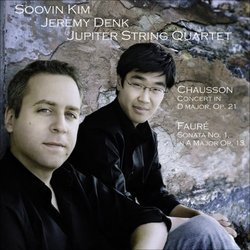Two French Chamber Music Classics; Two Rising Chamber Musici
J Scott Morrison | Middlebury VT, USA | 04/23/2009
(5 out of 5 stars)
"'Never have I had such a wonderful success! I can't quite get over it. Everyone seems to love the Concert.' Thus wrote Chausson in his diary after the first performance of his Concert in D major (1892), one of his earliest triumphs. The Concert (sometimes referred to as the Concerto) for piano, violin and string quartet is one of the gems of the chamber repertoire and because of its unusual instrumentation a fairly rare visitor to the concert stage. The work seems to lead to two distinctly different approaches. There is a steamy, erotically charged approach -- as in the recording by Augustin Dumay, Jean-Philippe Collard and the Muir Quartet Chausson: Concert En Re Majeur, Op. 21 Pour Piano, Violin et Quatuor A Cordes; Quatuor Acordes "Inacheve", Op. 35, and the Apollonian, lapidary approach as typified by the classic 1931 recording with Cortot and Thibaud Thilbaud & Cortot Play Franck & Chausson. Certainly the Concert, with its soaring melodic lines and its Franckian chromaticism allied with structural rigor, allows for both approaches. This performance by rising soloists violinist Soovin Kim and pianist Jeremy Denk, along with the Jupiter String Quartet, somehow bridges the gap; it is passionate and yet velvety smooth. One hears impeccable intonation, even in the animated finale, and nuanced phrasing along with perfect ensemble. Denk's playing is marked by a smooth sound, not the percussiveness that the score can elicit from some players. Kim is one of our rising violinists; his playing is silken, masterful. I had never heard of him until a performance heard at Marlboro a couple of years ago; I marked him out as an artist to watch. I'm delighted to find that he is now recording. I find that I am more keenly attracted to this performance the more I hear it.
Coupled with the Chausson is one of the most beloved of French violin sonatas, Fauré's First Sonata in A Major, Op. 13. It is both intimate and impetuous, a young man's outpouring as compared to the spare and somewhat enigmatic Second Sonata which came at the end of Fauré's life. It is a bit unusual in that three of its four movements are in sonata-allegro form, the only exception being the Mendelssohnian (and, to use Eric Blom's adjective, 'semiquaverish') scherzo. The whole quartet overflows with exquisite melodic ideas. This is an utterly assured performance by Kim and Denk, easily the equal of any other I know.
Enthusiastically recommended.
Scott Morrison"


 Track Listings (8) - Disc #1
Track Listings (8) - Disc #1